-
 Known in Australia for his iconic role in To The Manor Born, Peter Bowles has had a very rich and lively acting career, also playing in such well known series as The Saint, The Avengers and The Prisoner. His autobiography is full of entertaining stories featuring Rex Harrison, Richard Burton, Albert Finney, Marlon Brando, Alfred Hitchcock and many other names of the stage and screen. Illustrated with black and white and colour photographs.
Known in Australia for his iconic role in To The Manor Born, Peter Bowles has had a very rich and lively acting career, also playing in such well known series as The Saint, The Avengers and The Prisoner. His autobiography is full of entertaining stories featuring Rex Harrison, Richard Burton, Albert Finney, Marlon Brando, Alfred Hitchcock and many other names of the stage and screen. Illustrated with black and white and colour photographs. -
 Clive James began keeping a verse diary for 1982 and recounts the year - his own and world events - in verse! Everything gets a mention - from Maggie Thatcher to the birth of Prince William, Prince Andrew's pursuit of Koo Stark, the ongoing Lebanan/Israel conflict, the invasion of the Queen's bedroom in the small hours by Michael Fagan and the Falklands War.
Clive James began keeping a verse diary for 1982 and recounts the year - his own and world events - in verse! Everything gets a mention - from Maggie Thatcher to the birth of Prince William, Prince Andrew's pursuit of Koo Stark, the ongoing Lebanan/Israel conflict, the invasion of the Queen's bedroom in the small hours by Michael Fagan and the Falklands War. -
 This memoir, which Gypsy began as a series of pieces for The New Yorker, contains photographs and newspaper clippings from her personal scrapbooks and an afterword by her son, Erik Lee Preminger. By turns touching and hilarious, Gypsy describes her childhood trouping across 1920s America on the vaudeville circuit through to her rise to stardom as The Queen of Burlesque in 1930s New York - where gin came in bathtubs, gangsters were celebrities, and Walter Winchell was king. Her story features outrageous characters - among them Broadway’s funny girl, Fanny Brice, who schooled Gypsy in how to be a star; gangster Waxy Gordon - who bears an intriguing resemblance to Al Capone - who paid for her to have her teeth fixed; and her indomitable mother, Rose, who lived by her own version of the Golden Rule: “Do unto others … before they do you.” And here's a tale from her revue days: The manager had advertised the show as 'fifty beautiful girls, 45 glamorous costumes... Lee says, "And I was the one that convinced the customers that I was the other five girls!" With black and white photographs - and here's what some other readers thought: https://www.goodreads.com/book/show/143890.Gypsy?from_search=true&from_srp=true&qid=mqwbhqxEnt&rank=1
This memoir, which Gypsy began as a series of pieces for The New Yorker, contains photographs and newspaper clippings from her personal scrapbooks and an afterword by her son, Erik Lee Preminger. By turns touching and hilarious, Gypsy describes her childhood trouping across 1920s America on the vaudeville circuit through to her rise to stardom as The Queen of Burlesque in 1930s New York - where gin came in bathtubs, gangsters were celebrities, and Walter Winchell was king. Her story features outrageous characters - among them Broadway’s funny girl, Fanny Brice, who schooled Gypsy in how to be a star; gangster Waxy Gordon - who bears an intriguing resemblance to Al Capone - who paid for her to have her teeth fixed; and her indomitable mother, Rose, who lived by her own version of the Golden Rule: “Do unto others … before they do you.” And here's a tale from her revue days: The manager had advertised the show as 'fifty beautiful girls, 45 glamorous costumes... Lee says, "And I was the one that convinced the customers that I was the other five girls!" With black and white photographs - and here's what some other readers thought: https://www.goodreads.com/book/show/143890.Gypsy?from_search=true&from_srp=true&qid=mqwbhqxEnt&rank=1 -
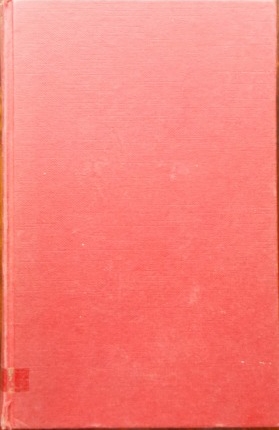
 The Dominance of the Duke of Northumberland. Edward VI (b. 1537; reigned 1547 - 1553) was not yet 10 years old when he ascended England's throne; the son of Henry VIII and Jane Seymour and England's first monarch to be raised as a Protestant. During his reign, the realm was governed by a regency council because he never reached maturity. The council was first led by his uncle Edward Seymour, 1st Duke of Somerset (1547–1549), and then by John Dudley, 1st Earl of Warwick (1550–1553), who from 1551 was Duke of Northumberland. Edward's reign was marked by economic problems and social unrest that in 1549 erupted into riot and rebellion. An expensive war with Scotland, at first successful, ended with military withdrawal from Scotland and Boulogne-sur-Mer in exchange for peace. The transformation of the Church of England into a recognisably Protestant body also occurred under Edward, who took great interest in religious matters. His short reign was, from start to finish, ruled by more than 30 counsellors and executors appointed by Henry VIII's will, causing a bitter power struggle. Edward VI named his cousin Lady Jane Grey as his successor, completely bypassing his half-sisters Anne and Elizabeth; Jane's reign lasted nine days before she was deposed by Mary.
The Dominance of the Duke of Northumberland. Edward VI (b. 1537; reigned 1547 - 1553) was not yet 10 years old when he ascended England's throne; the son of Henry VIII and Jane Seymour and England's first monarch to be raised as a Protestant. During his reign, the realm was governed by a regency council because he never reached maturity. The council was first led by his uncle Edward Seymour, 1st Duke of Somerset (1547–1549), and then by John Dudley, 1st Earl of Warwick (1550–1553), who from 1551 was Duke of Northumberland. Edward's reign was marked by economic problems and social unrest that in 1549 erupted into riot and rebellion. An expensive war with Scotland, at first successful, ended with military withdrawal from Scotland and Boulogne-sur-Mer in exchange for peace. The transformation of the Church of England into a recognisably Protestant body also occurred under Edward, who took great interest in religious matters. His short reign was, from start to finish, ruled by more than 30 counsellors and executors appointed by Henry VIII's will, causing a bitter power struggle. Edward VI named his cousin Lady Jane Grey as his successor, completely bypassing his half-sisters Anne and Elizabeth; Jane's reign lasted nine days before she was deposed by Mary. -
 This book is described as expertly informative for the intending tourist or the armchair tourist. The magnetic fields of Denmark, Norway and Sweden are visited as well as the less-trodden ways of Finland, Iceland and Greenland. The author is credited with a good eye for spectacular natural phenomena: the fire and snow in Iceland, Greenland's icy mountains, water, islands and sky as well as an interest in historical entertainments. From Kirkus Reviews: "The solid information outweighs the cafe chatter. However, the author cannot resist some sniggering appreciations of sex mores in Sweden and Denmark, which leads to an inane 'interview' with a quartet of Swedish damosels and a happy view of the nude bathing of a Finnish poet's wife. " Illustrated with numerous colour and black and white photographs.
This book is described as expertly informative for the intending tourist or the armchair tourist. The magnetic fields of Denmark, Norway and Sweden are visited as well as the less-trodden ways of Finland, Iceland and Greenland. The author is credited with a good eye for spectacular natural phenomena: the fire and snow in Iceland, Greenland's icy mountains, water, islands and sky as well as an interest in historical entertainments. From Kirkus Reviews: "The solid information outweighs the cafe chatter. However, the author cannot resist some sniggering appreciations of sex mores in Sweden and Denmark, which leads to an inane 'interview' with a quartet of Swedish damosels and a happy view of the nude bathing of a Finnish poet's wife. " Illustrated with numerous colour and black and white photographs. -
 From the moment of his accession to the close of his life, King George VI (b. 1895; reigned 1936 - 1952) was faced with a series of major emergencies - the aftermath of the abdication, the Czechoslovak crisis, the six searing years of war, followed by the grim austerity and grave problems of the post-war reconstruction period. In all these vital events the King played his own considerable part with an outstanding devotion to duty, sparing himself nothing and eventually succumbing to the strain of the burden of his office.Almost 900 pages of detailed research including genealogical charts and black and white photographs.
From the moment of his accession to the close of his life, King George VI (b. 1895; reigned 1936 - 1952) was faced with a series of major emergencies - the aftermath of the abdication, the Czechoslovak crisis, the six searing years of war, followed by the grim austerity and grave problems of the post-war reconstruction period. In all these vital events the King played his own considerable part with an outstanding devotion to duty, sparing himself nothing and eventually succumbing to the strain of the burden of his office.Almost 900 pages of detailed research including genealogical charts and black and white photographs. -
 The story of the greatest exploratory expedition ever performed in Man's history. It started in Melbourne; a convoy of sixteen men, twenty-four camels, innumerable pack-horses and a number of wagons carrying 20 tons of supplies. It ended with two exhausted, near-starving men, the leader and his second in command, deep in an impenetrable mangrove swamp on the edge of the Gulf of Carpentaria. Then began the long return trek, through swamp and desert, tormented by thirst and near starvation that reduced them to eating snakes and rats. Illustrated with sketches and photographs..
The story of the greatest exploratory expedition ever performed in Man's history. It started in Melbourne; a convoy of sixteen men, twenty-four camels, innumerable pack-horses and a number of wagons carrying 20 tons of supplies. It ended with two exhausted, near-starving men, the leader and his second in command, deep in an impenetrable mangrove swamp on the edge of the Gulf of Carpentaria. Then began the long return trek, through swamp and desert, tormented by thirst and near starvation that reduced them to eating snakes and rats. Illustrated with sketches and photographs.. -

 The story of a nation: on the 1st day of the 20th century, the Commonwealth of Australia came into being. Drawing on sources as diverse as Alfred Deakin's notebooks, Nettie Palmer's letters and the diary of a bank clerk named George M'Clure, Souter describes the birth of such Commonwealth institutions and symbols as parliament, the high court, the army and navy, the flag, income tax, the coat of arms and Canberra. There are lively narrative portraits of the young Commonwealth's great public figures: Barton, Reid, O'Malley, Griffith, Isaacs, Fisher, Hughes, Mannix and Monash - as well as Tom Thick, a telegram boy in western Victoria; Ida Dawson, a governess at a homestead near Collarenebri; Shaw Neilson, a Wimmera bush worker and poet; and Snowy Howe, a young pearler who went from Broome to Gallipoli.There is a wide panorama from the South African Veldt to the Somme for the first Empire Day in 1905 to the slaughter of Gallipoli, from leisurely Edwardian cruises 'home' to Ross Smith's extraordinary London-Melbourne flight in 1919. This is the initiation of Australia.
The story of a nation: on the 1st day of the 20th century, the Commonwealth of Australia came into being. Drawing on sources as diverse as Alfred Deakin's notebooks, Nettie Palmer's letters and the diary of a bank clerk named George M'Clure, Souter describes the birth of such Commonwealth institutions and symbols as parliament, the high court, the army and navy, the flag, income tax, the coat of arms and Canberra. There are lively narrative portraits of the young Commonwealth's great public figures: Barton, Reid, O'Malley, Griffith, Isaacs, Fisher, Hughes, Mannix and Monash - as well as Tom Thick, a telegram boy in western Victoria; Ida Dawson, a governess at a homestead near Collarenebri; Shaw Neilson, a Wimmera bush worker and poet; and Snowy Howe, a young pearler who went from Broome to Gallipoli.There is a wide panorama from the South African Veldt to the Somme for the first Empire Day in 1905 to the slaughter of Gallipoli, from leisurely Edwardian cruises 'home' to Ross Smith's extraordinary London-Melbourne flight in 1919. This is the initiation of Australia. -
 This biographical volume covers the lives great stage actors of the period 1740 - 1914 in six critical yet easy-to-read essays: David Garrick; John Kemble; Edmund Kean; W.C. Macready; Sir Henry Irving and Sir Johnston Forbes-Robertson. The author did not attempt to solve the question of what makes a great actor, but instead offers six kinds of greatness. A book for anyone interested in the magic, glamour and history of the stage. Illustrated with black and white sketches and photographs.
This biographical volume covers the lives great stage actors of the period 1740 - 1914 in six critical yet easy-to-read essays: David Garrick; John Kemble; Edmund Kean; W.C. Macready; Sir Henry Irving and Sir Johnston Forbes-Robertson. The author did not attempt to solve the question of what makes a great actor, but instead offers six kinds of greatness. A book for anyone interested in the magic, glamour and history of the stage. Illustrated with black and white sketches and photographs. -
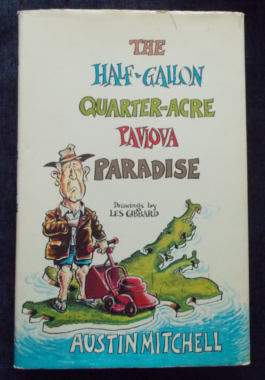 Mitchell, a former English resident of New Zealand, has written the funniest, frankest and most provocative book about New Zealand, its people, its institutions - in fact, the New Zealand way of life. His shafts, often barbed, a aimed freely at people and institutions but he is well-disposed to New Zealand and New Zealanders and perhaps the natural progression of events is that on his return to England, Mitchell became a Member for Parliament for Great Grimsby, 1977-2015.
Mitchell, a former English resident of New Zealand, has written the funniest, frankest and most provocative book about New Zealand, its people, its institutions - in fact, the New Zealand way of life. His shafts, often barbed, a aimed freely at people and institutions but he is well-disposed to New Zealand and New Zealanders and perhaps the natural progression of events is that on his return to England, Mitchell became a Member for Parliament for Great Grimsby, 1977-2015. -
 The zestful, indefatigable and irrepressible Frank Clune investigates great cities and small villages, as well as an Old Master or two and chats to a young mechanic - and that contributes to the diversity of his presentation of historical backgrounds and the contemporary feel of the countries he visits - or as he calls it, Random Rambles in Paris, Eire, Iceland, Vienna and Belgium. Illustrated with black and white photographs.
The zestful, indefatigable and irrepressible Frank Clune investigates great cities and small villages, as well as an Old Master or two and chats to a young mechanic - and that contributes to the diversity of his presentation of historical backgrounds and the contemporary feel of the countries he visits - or as he calls it, Random Rambles in Paris, Eire, Iceland, Vienna and Belgium. Illustrated with black and white photographs. -
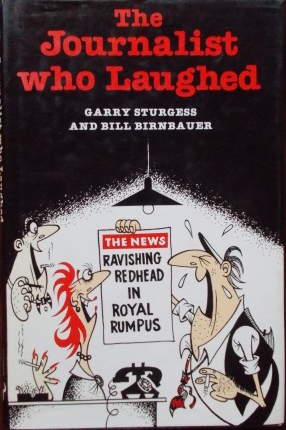 Journalists are an irreverent breed who must find humour in any event in order to stay sane. Here is a fabulously varied collection of stories from Frank and Kerry packer, Rupert Murdoch, Ita Buttrose, Ron Saw and many others on the world where truth is often stranger than fiction...When screen goddess Ava Gardner was in Melbourne for the filming of On The Beach (1959) a young reporter was told to get Miss Gardner's opinions of Melbourne, her latest romance, the film, etc. No interviews were being given by anyone and all the reporter could garner was a few scraps of information about the stars and the filming locations. So he concocted a story, the last paragraph being an alleged quote from Miss Gardner via a rumour at third hand from a usually reliable source: "On The Beach is a story about the end of the world and Melbourne sure is the right place to make it." The reporter fully expected that the editor would cut it, realising it was a practical joke. The 'quote' went viral world-wide and was included by by writers whenever mentioning Melbourne (or even Australia) for the next twenty years. In 1980 Miss Gardner was asked about the now-hackneyed quote. She said she couldn't remember saying it, but it was funny and she'd be happy to take the credit for it. The reporter - in 1982 - issued a formal confession and apology to Miss Gardner.
Journalists are an irreverent breed who must find humour in any event in order to stay sane. Here is a fabulously varied collection of stories from Frank and Kerry packer, Rupert Murdoch, Ita Buttrose, Ron Saw and many others on the world where truth is often stranger than fiction...When screen goddess Ava Gardner was in Melbourne for the filming of On The Beach (1959) a young reporter was told to get Miss Gardner's opinions of Melbourne, her latest romance, the film, etc. No interviews were being given by anyone and all the reporter could garner was a few scraps of information about the stars and the filming locations. So he concocted a story, the last paragraph being an alleged quote from Miss Gardner via a rumour at third hand from a usually reliable source: "On The Beach is a story about the end of the world and Melbourne sure is the right place to make it." The reporter fully expected that the editor would cut it, realising it was a practical joke. The 'quote' went viral world-wide and was included by by writers whenever mentioning Melbourne (or even Australia) for the next twenty years. In 1980 Miss Gardner was asked about the now-hackneyed quote. She said she couldn't remember saying it, but it was funny and she'd be happy to take the credit for it. The reporter - in 1982 - issued a formal confession and apology to Miss Gardner. -
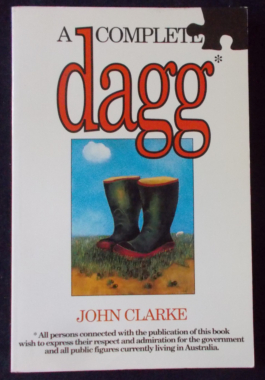 Complete dagg John 'Nobby' Clarke (1948-2017) claimed a PhD in Cattle and held important positions with Harrods, Selfridges and Easibind; was sacked by ABC Radio and worked for various defunct newspapers; he enjoyed such recreations as reading theological works and dog trials. His address was care of the people next door. (Or just pop it inside the door of fuse box for Friday collection.) He really was the complete dagg. Chapters include: Australia - A User's Guide; Celebrity Interviews - luminaries include the late Bob Hawke, Prince Charles and Meryl Streep; Farnarkeling; The Resolution of Conflict; Golf (extensively covered...) This Week On ABC Television; Australiaform; Australia And How To Repair It (with a section on Troubleshooting); Very Worrying Developments.
Complete dagg John 'Nobby' Clarke (1948-2017) claimed a PhD in Cattle and held important positions with Harrods, Selfridges and Easibind; was sacked by ABC Radio and worked for various defunct newspapers; he enjoyed such recreations as reading theological works and dog trials. His address was care of the people next door. (Or just pop it inside the door of fuse box for Friday collection.) He really was the complete dagg. Chapters include: Australia - A User's Guide; Celebrity Interviews - luminaries include the late Bob Hawke, Prince Charles and Meryl Streep; Farnarkeling; The Resolution of Conflict; Golf (extensively covered...) This Week On ABC Television; Australiaform; Australia And How To Repair It (with a section on Troubleshooting); Very Worrying Developments. -
 The colourful and exciting story of Australian aviation and the men who chanced their lives in the primitive 'box kites' and gliders that were literally made from wood, wire and fabric. Thanks to these men, it was not long before Australia was brought nearer to the rest of the world by spanning oceans and continents. With fabulous archival photographs.
The colourful and exciting story of Australian aviation and the men who chanced their lives in the primitive 'box kites' and gliders that were literally made from wood, wire and fabric. Thanks to these men, it was not long before Australia was brought nearer to the rest of the world by spanning oceans and continents. With fabulous archival photographs. -
 Bill Scott became a 'battler' after his hilarious discharge from the Royal Australian Navy in 1949, after which he sets off round Queensland to try his hand at many occupations: 'fail-safe' gold prospecting with his mate Johnny (not much gold but lots of fun and experience) ; copper mining in Mount Isa, described as a kind of 'Foreign Legion' existence where men didn't speak about their pasts; cane cutting, one of the hardest labour jobs at that time and finally becoming 'fireman' on the little steam locomotives that help collect the cane harvest and take it to the mills for crushing. And throughout, he meets a swag of colourful characters and intriguing adventures. A real life adventure. Apparently, this is not a book for the 'politically correct' reader.
Bill Scott became a 'battler' after his hilarious discharge from the Royal Australian Navy in 1949, after which he sets off round Queensland to try his hand at many occupations: 'fail-safe' gold prospecting with his mate Johnny (not much gold but lots of fun and experience) ; copper mining in Mount Isa, described as a kind of 'Foreign Legion' existence where men didn't speak about their pasts; cane cutting, one of the hardest labour jobs at that time and finally becoming 'fireman' on the little steam locomotives that help collect the cane harvest and take it to the mills for crushing. And throughout, he meets a swag of colourful characters and intriguing adventures. A real life adventure. Apparently, this is not a book for the 'politically correct' reader. -
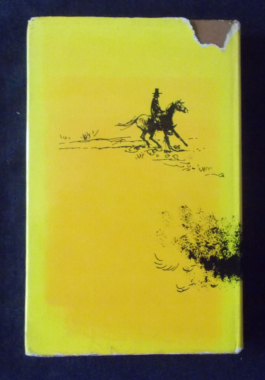
 Here is a roistering view of Australian from the time of the First Fleet onward, as seen by men and women who expressed their opinions of the country and each other in language forthright, abusive, wistful or cheerful. Part One is devoted to popular (and uniquely Australian) sayings, jests, rhymes, anecodotes and yarns...The bushman recounted, 'When I was doin' a bit o' grave diggin' at Guyra, it so was so perishin' cold there one winter we were forced to demand two weeks' notice of anyone who was goin' to die. It took us that long to dig the hole.' Part Two is Australian Perspectives 1788 - 1918: Farmer's Pride and Prisoner's Hell; The Southern El Dorado (includes a recipe for damper and Black Swans as Table Birds...); An Album of Victoriana; Land of Hope and Glory. You won't get anything more dinki-di than this volume.
Here is a roistering view of Australian from the time of the First Fleet onward, as seen by men and women who expressed their opinions of the country and each other in language forthright, abusive, wistful or cheerful. Part One is devoted to popular (and uniquely Australian) sayings, jests, rhymes, anecodotes and yarns...The bushman recounted, 'When I was doin' a bit o' grave diggin' at Guyra, it so was so perishin' cold there one winter we were forced to demand two weeks' notice of anyone who was goin' to die. It took us that long to dig the hole.' Part Two is Australian Perspectives 1788 - 1918: Farmer's Pride and Prisoner's Hell; The Southern El Dorado (includes a recipe for damper and Black Swans as Table Birds...); An Album of Victoriana; Land of Hope and Glory. You won't get anything more dinki-di than this volume. -
 As the 1940s came to a close, the dream factory of Hollywood was in turmoil: McCarthyism was a dark shadow, television had begun to make inroads and there was the realism of post-war society. But five young actors came west: James Dean; Rock Hudson; Montgomery Clift; Elizabeth Taylor and Natalie Wood. They became the idols of their generation. As well as their stories, this book encapsulates the glamour, the hype, the delusions and scandals that was the Hollywood of the Fifties. With black and white photographs.
As the 1940s came to a close, the dream factory of Hollywood was in turmoil: McCarthyism was a dark shadow, television had begun to make inroads and there was the realism of post-war society. But five young actors came west: James Dean; Rock Hudson; Montgomery Clift; Elizabeth Taylor and Natalie Wood. They became the idols of their generation. As well as their stories, this book encapsulates the glamour, the hype, the delusions and scandals that was the Hollywood of the Fifties. With black and white photographs. -
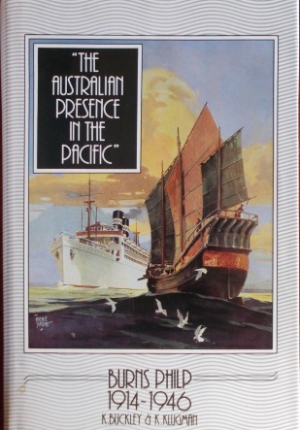 This is the second and final volume of the centenary history of Burns, Philp and Co. During the years reviewed in this volume (1914 - 1946) Burns Philp was firmly established as a merchant in Australia and the South Pacific,renowned as a buyer of copra, a seller of merchandise, plantation owner, shipowner and provider of credit.Within three months of the beginning of World War I, James Burns was carving up the map of the South Pacific; and there is an account of Australian planters acquiring the former German plantations in New Guinea, followed by covert German attempts to re-establish themselves in the Territory. The effects of the Great Depression and the success of the company in coming through it are portrayed vividly.
This is the second and final volume of the centenary history of Burns, Philp and Co. During the years reviewed in this volume (1914 - 1946) Burns Philp was firmly established as a merchant in Australia and the South Pacific,renowned as a buyer of copra, a seller of merchandise, plantation owner, shipowner and provider of credit.Within three months of the beginning of World War I, James Burns was carving up the map of the South Pacific; and there is an account of Australian planters acquiring the former German plantations in New Guinea, followed by covert German attempts to re-establish themselves in the Territory. The effects of the Great Depression and the success of the company in coming through it are portrayed vividly. -
 Based on meticulous research and interviews with dozens of family members, friends, lovers, directors, and costars, Rebel offers a revelatory look at actor and film icon James Dean (1931-1955) - cinema's most enduring symbol of rebellious youth, has held the world's fascination since his tragic death at the age of twenty-four. From the dusty roads of rural Indiana to Manhattan's gay culture, from Broadway to Burbank, here is Dean's troubled life: the tragic death of his mother when he was nine; his tumultuous relationship with his father; his rise to stardom in New York and Hollywood and his on-and off-screen exploits. With black and white photos.
Based on meticulous research and interviews with dozens of family members, friends, lovers, directors, and costars, Rebel offers a revelatory look at actor and film icon James Dean (1931-1955) - cinema's most enduring symbol of rebellious youth, has held the world's fascination since his tragic death at the age of twenty-four. From the dusty roads of rural Indiana to Manhattan's gay culture, from Broadway to Burbank, here is Dean's troubled life: the tragic death of his mother when he was nine; his tumultuous relationship with his father; his rise to stardom in New York and Hollywood and his on-and off-screen exploits. With black and white photos. -
 From the author of I Can Jump Puddles. It's time to visit Alan Marshall's Australia: sitting on the sliprail exchanging yarns, driving a buggy down long dusty trails. And meet such wonderful characters as Lance Skuthorpe, who tethered a bull in Bourke Street and offered five quid to anyone who could ride him for half a minute and Binjarrpooma, the terror of Arnhem Land. Make a visit to an Australia that is now gone.
From the author of I Can Jump Puddles. It's time to visit Alan Marshall's Australia: sitting on the sliprail exchanging yarns, driving a buggy down long dusty trails. And meet such wonderful characters as Lance Skuthorpe, who tethered a bull in Bourke Street and offered five quid to anyone who could ride him for half a minute and Binjarrpooma, the terror of Arnhem Land. Make a visit to an Australia that is now gone. -
 Empires remain alive in our minds by dint of the great works they achieve. And the Roman empire is still the world's preceptor in politics, law, administration and the art of war. Her legal advisors laid the foundations of justice and morals in society; her municipal system has handed down criteria of administration still in use today. The Romans built triumphal arches, the domed Pantheon, aqueducts, circuses and amphitheatres for their captains, the needs of their empire and the pleasure of their great cities, in addition to their military roads which spread their will to the ends of the earth. They also created the Coliseum and the Thermal Baths of Caracella, so majestic they can be taken as a symbol of Roman dominion. The scandal of Roman orgies surpassed anything that had been seen in the Orient; Latin is the parent of many modern languages; and for Cicero, Seneca and Tacitus, the most imperious need was the free possession of the self. With colour and blak and white photographs and artistic representations of events, places and people.
Empires remain alive in our minds by dint of the great works they achieve. And the Roman empire is still the world's preceptor in politics, law, administration and the art of war. Her legal advisors laid the foundations of justice and morals in society; her municipal system has handed down criteria of administration still in use today. The Romans built triumphal arches, the domed Pantheon, aqueducts, circuses and amphitheatres for their captains, the needs of their empire and the pleasure of their great cities, in addition to their military roads which spread their will to the ends of the earth. They also created the Coliseum and the Thermal Baths of Caracella, so majestic they can be taken as a symbol of Roman dominion. The scandal of Roman orgies surpassed anything that had been seen in the Orient; Latin is the parent of many modern languages; and for Cicero, Seneca and Tacitus, the most imperious need was the free possession of the self. With colour and blak and white photographs and artistic representations of events, places and people. -
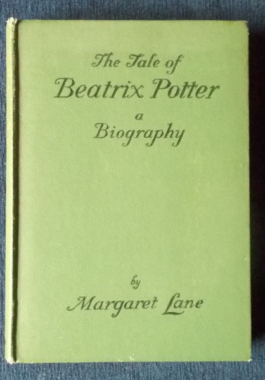 Beatrix Potter lived a modest, unsensational and private life. The first few decades were spent in being governess-taught at home and with few friends outside of her brother and extended family and in being the dutiful daughter. She loved to study nature and became a very good natural scientist - but by 1897, Beatrix was 31 and searching for more independent activities, wishing to earn some money of her own while dutifully taking care of her parents, dealing with her especially demanding mother as well as managing their various households. From painting natural botanical specimens she progressed to fantasy pictures of animals and thence to the book that became the classic Tale Of Peter Rabbit. And the rest - of course - is history. This biography was only made possible with the assistance of her family friends - the tale of the creator behind the perennial animal stories beloved by generations of children. Includes four colour plates and sixteen black and white photographs.
Beatrix Potter lived a modest, unsensational and private life. The first few decades were spent in being governess-taught at home and with few friends outside of her brother and extended family and in being the dutiful daughter. She loved to study nature and became a very good natural scientist - but by 1897, Beatrix was 31 and searching for more independent activities, wishing to earn some money of her own while dutifully taking care of her parents, dealing with her especially demanding mother as well as managing their various households. From painting natural botanical specimens she progressed to fantasy pictures of animals and thence to the book that became the classic Tale Of Peter Rabbit. And the rest - of course - is history. This biography was only made possible with the assistance of her family friends - the tale of the creator behind the perennial animal stories beloved by generations of children. Includes four colour plates and sixteen black and white photographs. -
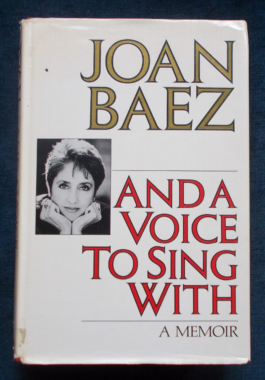 Joan Baez, the undisputed Queen of Folk, was catapulted to fame after her appearance at the 1958 Newport Folk Festival. Here, she not only tells her story, but the story of the changing social history of her time, from the smoke-filled coffee houses of the 1950s to the Vietnam war protests, Woodstock and beyond.
Joan Baez, the undisputed Queen of Folk, was catapulted to fame after her appearance at the 1958 Newport Folk Festival. Here, she not only tells her story, but the story of the changing social history of her time, from the smoke-filled coffee houses of the 1950s to the Vietnam war protests, Woodstock and beyond. -
 The tale of the White Star Liner Oceanic which struck a remote reef of Shetland and sank in 1914, just after the outbreak of World War One. This 'Queen of the Seas' was more magnificently luxurious than her famous sister Titanic. It is remarkable that the disaster was scarcely heard of at the time and is now all but forgotten; but it was wartime; secrecy was paramount and the line had been taken over by the Royal Navy and had become the armed cruiser HMS Oceanic, yet still retaining its grand marble bathrooms, gilt carvings, gold-plated fittings and stained glass domes. The cause of the disaster is classic - there were two captains; one naval and the other merchant navy, although the naval officer was in supreme command. The ship was on patrol off the north coast of Scotland; the navigator was miles out in in his estimate of of its position on September 8 and when the mist cleared, instead of being well south and west of the isle of Foula, the ship was east of it and heading straight for the terrible Shaalds reef. After that, mistake piled on mistake - the bow struck and the tide pushed the ship further onto the reef; and the giantess was poised briefly before breaking up and sinking. A remarkable salvage operation of the Oceanic was achieved in 1974.
The tale of the White Star Liner Oceanic which struck a remote reef of Shetland and sank in 1914, just after the outbreak of World War One. This 'Queen of the Seas' was more magnificently luxurious than her famous sister Titanic. It is remarkable that the disaster was scarcely heard of at the time and is now all but forgotten; but it was wartime; secrecy was paramount and the line had been taken over by the Royal Navy and had become the armed cruiser HMS Oceanic, yet still retaining its grand marble bathrooms, gilt carvings, gold-plated fittings and stained glass domes. The cause of the disaster is classic - there were two captains; one naval and the other merchant navy, although the naval officer was in supreme command. The ship was on patrol off the north coast of Scotland; the navigator was miles out in in his estimate of of its position on September 8 and when the mist cleared, instead of being well south and west of the isle of Foula, the ship was east of it and heading straight for the terrible Shaalds reef. After that, mistake piled on mistake - the bow struck and the tide pushed the ship further onto the reef; and the giantess was poised briefly before breaking up and sinking. A remarkable salvage operation of the Oceanic was achieved in 1974. -
 Ukrainian-born Irène Némirovsky was already a successful writer in the early 1940s and living in Paris. She was also Jewish and in 1942 she was arrested and deported to Auschwitz: a month later she was dead at the age of thirty-nine. She intended Suite Française to be a five-part novel but at the time of her death, she had only completed the first two parts. The handwritten manuscripts were hidden in a suitcase that her daughters would take with them into hiding and eventually into freedom. A Storm In June: In the chaos of the massive 1940 exodus from Paris on the eve of the Nazi invasion, several families and individuals are thrown together under circumstances beyond their control. They share nothing but the harsh demands of survival - some try to maintain lives of privilege, others struggle simply to preserve their lives - but soon they will be forced to face physical and emotional displacement and the annihilation of the world they know. Dolce: Life in a German-occupied provincial village becomes increasingly complex and uneasy as the villagers - from aristocrats to shopkeepers to peasants - cope as best they can with the soldiers billeted amongst them. Some choose resistance, others collaboration - and lives are transformed by each and every choice. Irène Némirovsky saw that true nobility and love did exist but often in the most surprising places.
Ukrainian-born Irène Némirovsky was already a successful writer in the early 1940s and living in Paris. She was also Jewish and in 1942 she was arrested and deported to Auschwitz: a month later she was dead at the age of thirty-nine. She intended Suite Française to be a five-part novel but at the time of her death, she had only completed the first two parts. The handwritten manuscripts were hidden in a suitcase that her daughters would take with them into hiding and eventually into freedom. A Storm In June: In the chaos of the massive 1940 exodus from Paris on the eve of the Nazi invasion, several families and individuals are thrown together under circumstances beyond their control. They share nothing but the harsh demands of survival - some try to maintain lives of privilege, others struggle simply to preserve their lives - but soon they will be forced to face physical and emotional displacement and the annihilation of the world they know. Dolce: Life in a German-occupied provincial village becomes increasingly complex and uneasy as the villagers - from aristocrats to shopkeepers to peasants - cope as best they can with the soldiers billeted amongst them. Some choose resistance, others collaboration - and lives are transformed by each and every choice. Irène Némirovsky saw that true nobility and love did exist but often in the most surprising places. -
 'We're happy little Vegemites, as bright as bright can be...' Who remembers Vegemite sandwiches in their school lunch boxes? Or, when you felt a bit crook, Vegemite on Sao biscuits to settle your stomach? Generations of Aussie kids have been raised on Vegemite. In 1992, Kraft produced the 70th Happy Birthday Vegemite book, full of games, memorabilia, recipes, advertisement and facts all about Vegemite. V not only stood for Vegemite - it stood for vitamins and vitality, vim and vigor!
'We're happy little Vegemites, as bright as bright can be...' Who remembers Vegemite sandwiches in their school lunch boxes? Or, when you felt a bit crook, Vegemite on Sao biscuits to settle your stomach? Generations of Aussie kids have been raised on Vegemite. In 1992, Kraft produced the 70th Happy Birthday Vegemite book, full of games, memorabilia, recipes, advertisement and facts all about Vegemite. V not only stood for Vegemite - it stood for vitamins and vitality, vim and vigor!



